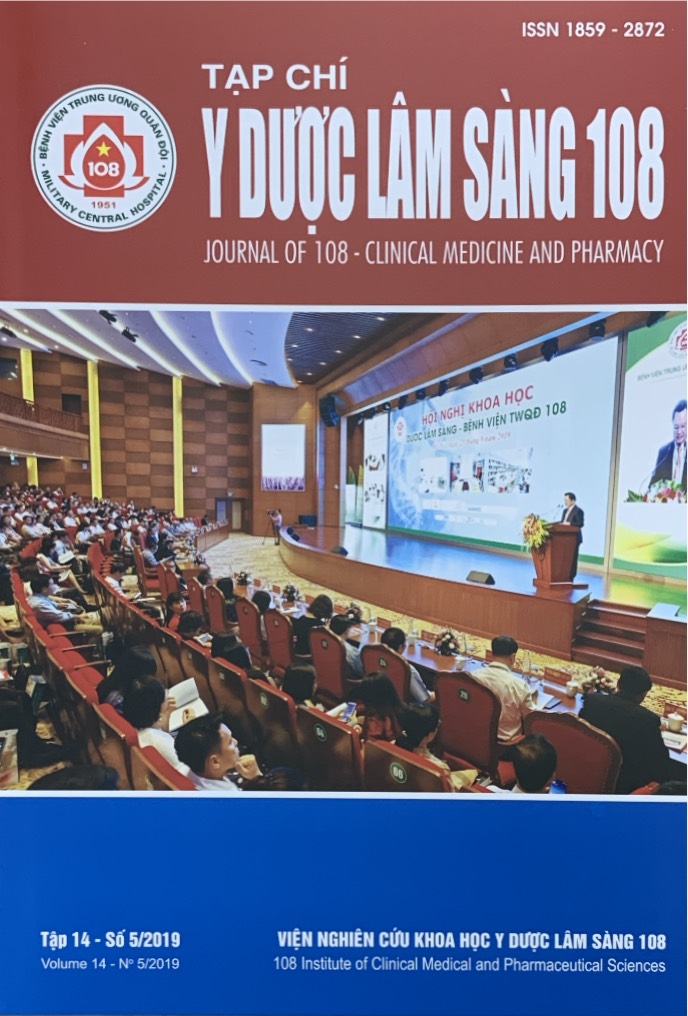Indications, techniques of laparoscopic common bile duct exploration combined with cholangioscopy and electrodydraulic lithotripsy to treat extra- and intra-hepatolithiasis
Main Article Content
Keywords
Abstract
Objective: This study is to review the indications and techniques of laparoscopic common bile duct exploration combined with cholangioscopy and electrohydraulic lithotripsy to treatment the stone in extra- and intra-hepatolithiasis. Subject and method: From May 2015 to July 2017, 111 patients with extra and intra-hepatolithiasis, who have undergone laparoscopic common bile duct exploration combined with cholangioscopy and electrohydraulic lithotripsy in Vietnamese-Swedish Uong Bi Hospital and Ho Chi Minh City Medicine and Pharmacy University were enrolled in the prospective study. Result: Indications: 71.17% patient with extrahepatolithiasis, 9.00% patient with intrahepatolithiasis, and percentage of patient with both extrahepatolithiasis and intrahepatolithiasis was 19.82%. Selective surgery was 89.19% and emergency surgery was 10.81%. Laparoscopic common bile duct exploration after failed endoscopic retrograde cholangiopancreatography in 11.71%. The proportion of patients with a history of abdominal surgery was 36.93% of which the recurrent gallstones were 16.21%. Techniques: The average number of trocars has been used 4.17 ± 0.66. Transcholedocal approach to remove stones was 89.72% and transcystic approach was 10.28%. The methods of stone removing were basket 43.93%, electrohydraulic lithotripsy 27.10% and Mirizzi 16.82%. T-tube drainage have placed into common bile duct account for 83.16% and primary closure of choledochotomy was 7.47%. Duodenal perforation occurred in 1 case during dissection and was repaired laparoscopically. Conclusion: The indications of laparoscopic common bile duct exploration combined with cholangioscopy and electrohydraulic lithotripsy in management stone in extra- and intrahepatolithiasis is being widened. This method is feasible and safe in Vietnam.
Article Details
References
2. Nguyễn Ngọc Bích (2009) Kết quả phẫu thuật nội soi lấy sỏi và khâu ngay ống mật chủ tại Bệnh viện Bạch Mai. Tạp chí Y học thực hành, 6, tr. 34-37.
3. Nguyễn Khắc Đức và cộng sự (2006) Phẫu thuật nội soi điều trị sỏi đường mật chính tại Bệnh viện Việt Đức. Tạp chí Y học Việt Nam, số đặc biệt, tr. 320-325.
4. Lê Quốc Phong và cộng sự (2011) Nghiên cứu ứng dụng và kết quả phẫu thuật nội soi mở ống mật chủ lấy sỏi điều trị sỏi đường mật. Tạp chí Y học thực hành, tr. 35-37.
5. Koc B et al (2013) Comparison of laparoscopic common bile duct exploration and endoscopic retrograde cholangiopancreatography plus laparoscopic cholecystectomy for choledocholithiasis: A prospective randomized study. Am J Surg 206(4): 457-63.
6. Paganini AM et al (2007) Thirteen years' experience with laparoscopic transcystic common bile duct exploration for stones. Effectiveness and long-term results. Surg Endosc 21(1): 34-40.
7. Pu Q et al (2017) Reoperation for recurrent hepatolithiasis: Laparotomy versus laparoscopy. Surg Endosc 31(8): 3098-3105.
8. Stoker ME et al (1991) Laparoscopic common bile duct exploration. J Laparoendosc Surg 1(5): 287-293.
9. Zhang K et al (2016) Primary closure following laparoscopic common bile duct reexploration for the patients who underwent prior biliary operation. Indian J Surg 78(5): 364-370.
10. Zhu B et al (2014) Comparison of emergent versus elective laparoscopic common bile duct exploration for patients with or without nonsevere acute cholangitis complicated with common bile duct stones. J Surg Res 187(1): 72-76.
 ISSN: 1859 - 2872
ISSN: 1859 - 2872
